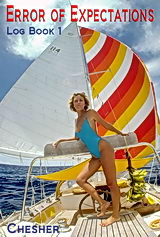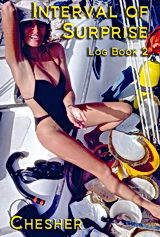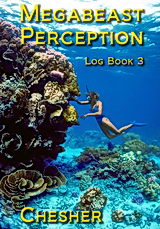Lolorua, oh Lolorua
Concepts struggle in fields of conception to match perception to ancient recall
The Lolorua burbles happily through the pass with Earthwatch Team VI waving gaily. Lolorua is an old, wooden 40 foot World War II inter-island boat. She's cluttered from stem to stern with all the various junk we need for the expedition. She met the team in Alotau yesterday and left Samarai at dawn. She carries a crew of two PNG fisheries men plus Leo's young friend. Leo's face lights up when he sees his friend on the bow, waving at him.
The Earthwatch team has five people from the U.S. and Colin Shelly, an English student at the University of PNG studying sea cucumbers. He has been on two previous teams and we have become friends. It's good to see him back. According to Earthwatch, the new people are Mike, Chuck, Patty, Louise and Anastasia.
We go over to meet them as the captain drops the anchor next to Moira. They are all young, athletic, and ready to go diving. We load all their gear into Lolorua's big aluminum dinghy and motor over to the island. They set up their tents quickly and efficiently and we gather on the beach for a briefing.
"This is the last team of the expeditions and we will be finishing the survey, along the outer barrier reef from here almost to Tagula." I begin, outlining the area on a chart laid out on the sand. "It's an area few outsiders have ever visited. Even the local fishermen, who consider the area their fishing zone, don't get out here too often." All of us smile at the thought of diving unexplored regions.
"You should all be familiar with the aims of the survey from your briefing book. So far, what we've found more or less confirms what I expected to find. There is not much in the way of commercial produce to support the proposed fisheries program. As you will see, live coral reefs have a lush and diverse fauna but well developed coral reefs are limited in extent." I tap the driftwood stick on the chart, "I expect we'll find well developed reefs here, in the passes, maybe a narrow fringe behind and in front of the reef and a few widely scattered patches in the lagoon.
"Each kind of commercially valuable invertebrate - lobster, green snail, trochus, giant clam, pearl oyster, beche-de-mer, black coral, and sponge - has its own special habitat. So, within the limited reef system, the invertebrates have a very patchy distribution. Even where the habitat looks more or less even, the giant clams or the lobsters or whatever form small clusters.
"What this means is, although the map shows an immense amount of shallow water, most of it is sand or rubble with no commercial organisms of any kind. The suitable habitats are still extensive and we could never sample all of them. We'll pick the best spots and survey these." I look up for any questions.
"How many animals will we need to recognize?" Patty looks worried.
"Eight general types. But there are five species of giant clams, three species of lobsters, three kinds of valuable sponges, and four commercially valuable species of sea cucumbers. You will have to be able to find and recognize About 20 different animals. I'll show you some of them today on our first check out dive. Others we can look at in books until we find examples on the reef. Recognizing the animals won't be a problem. Seeing them is the problem. They are often very well camouflaged and we will have to learn to work together as a team to move like so," I draw a pattern in the sand with a stick showing divers moving in a line along a reef, "very slowly, almost arm to arm apart."
"I'm ready," grins Mike, a commercial air line pilot.
"OK. But before we go, how many of you are certified divers?" They all are, I sigh with relief. "How many of you have ever been diving in tropical reef waters before?" Two have not.
"You have two major dangers to worry about when snorkeling out there on the reef," They respond with concerned looks, "The first is sunburn. As it says in the briefing material, you should always wear something in the water to protect your back and even your legs from the sun."
"What's the second thing?" asks Anastasia, "Sharks?".
"There are many dangerous animals out there and we will definitely see some sharks. But as long as you stick with the team and react calmly, treating the shark the way you would a big dangerous dog, they are not likely to be a serious danger. The most probable source of injury will be blundering into something with spines or sharp edges, like sea urchins or corals. The answer to this danger is to keep out of the surf and watch where you put your arms and legs." I smile and they do, too. "Sounds easy, but we've had minor injuries on every team."
"If anyone gets any injury or feels ill, come and tell Freddy or myself immediately. That's vital. Coral cuts can become dangerously infected. Once the skin closes over a coral cut marine yeast and fungi and bacteria can continue to grow in your flesh causing ulcers. Ulcers from coral cuts or fish spine cuts can go right down to the bone and cause severe bone infection. Normal antibiotics don't work on them. Putting iodine or most of the topical antiseptics on coral cuts is useless, too. The only way to kill the marine yeast, fungi and bacteria is to put full strength bleach on the cut within an hour or so. The sooner you get bleach on the cut the better, but it must be done before the cut seals over."
"You mean, like Clorox?" Patty looks doubtful.
"Right. We carry a bottle in the boat with us at all times. If - rather when - you get cut, put some on. It's best if the cut is still bleeding."
"Christ, that must hurt like hell," Mike winces.
"Not much," I laugh, getting up from the beach. "Not anywhere near as much as coral ulcers do. Let's get wet!"
Wari, a grey peak on the horizon to the northwest, is the only sign of land.
Huge breakers thunder down onto the outer barrier reef as Leo guides his fishing boat out
through the pass. The water is gin clear. We can see complex coral assemblies on the
bottom some 30 to 50 feet below. Life is crowded in the rapid current of the ocean pass.
The tide is coming in so we go to the outer edge of the pass, where the swell lifts and
falls and the sea is a dark, dark blue.
"Keep together as much as possible," I shout over the engine noise. "We will be going with the current and don't have to swim, just float. Don't try to stop and if you have a problem notify your buddy and surface. Leo will be following us, drifting with the current. Just get back in the boat and wait for us to surface. If you don't have any problems we'll go right through the pass and when we reach the sand area behind the reef we come up. OK?"
"OK" everyone shouts. We gear up while Leo holds station on the edge of the deep blue. On my signal we fall into the water, team up with our buddies, and spread out. I am on the west end of the line, Freddy on the other. We descend to about 15 meters and see a group of small sharks vanish into the deep blue of the outer sea. No wonder. The line of bubbling divers must make a formidable sight.
The pass is ahead, alive with fish and coral. Because of the rapid currents, lots of nutrients wash through the pass. It is an area of vibrant life: crinoids, sponges, gorgonians, and many other filter feeding animals, in addition to corals, vie for space along the jagged walls.
Our survey line is a bit ragged as we reach the pass but not bad. Everyone holds a plastic writing slate, ready to mark target animals in the appropriate columns. As the pass narrows around us, the current accelerates. Although we are just hovering, we soar with the current over the bottom at three or four knots. It is exhilarating. It is fantastic. It is beautiful.
I see the long white feelers of two lobsters ahead and dive lower, I count four under the ledge. I mark down a black lip pearl oyster, a giant clam, another (both Tridacna maxima), as I scan back and forth within the three meter swath of my section. It's hard to concentrate because it's so much fun. I check the line. Everybody OK. The water is so clear I can see all the way to the opposite side of the pass. Inside the barrier reef, the pass broadens, and the current slows, everyone is concentrating on their narrow survey path. All too soon, we shoot out over a broad sandy desert. I count eight beche-de-mer, none of them are commercially valuable. That's it. I signal the team to surface.
"Whoooooooeeeee!" Shouts Mike, "That was wild!"
"Lets go again," laughs Colin, followed by cheers of agreement. So we do it again and its even more fun the second time.
We shed our tanks and motor over behind the reef and anchor. Freddy distributes lunch and we excitedly compile our notes. Colin and Freddy and I have reasonable scores and, surprisingly, Mike and Patty have done well for their first real survey. The others will learn.
After lunch and a rest, we snorkel along the back of the reef heading southeast, me on the outer, deeper end of the line, Freddy up on top of the barrier reef and everyone else between. Colin is next to me counting sea cucumbers. I can rely on his data as he has been counting sea cucumbers for more than a year now. I see a gigantic clam, nearly a meter and a half in length."Hey!" I shout, "Come see this Tridacna gigas" and the team breaks pattern and clusters around the huge creature. It must weigh a couple of hundred kilograms.
"I never would have seen it," Louise complains, "It's so well camouflaged."
"Are we swimming to fast for you to see well?" I ask after getting everyone's attention.
"Yes," Freddy stands up in the knee deep water on top of the reef.
"OK, Freddy, you set the pace," I call, "Everybody keep in line with Freddy, move slow, and look very carefully."
We are exhausted at the end of the day as Leo brings us alongside the Lolorua. I drop Freddy off on Moira and ferry the participants ashore.
I have managed to sunburn my lips and they hurt like hell. I cut a leaf from our Aloe plant and smear on the cooling sap. It tastes terrible. In a few seconds the pain is gone, but the burn lingers on.



